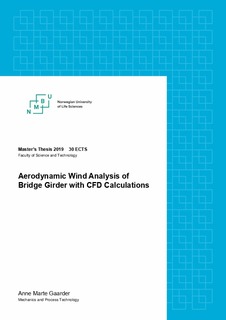| dc.contributor.advisor | Nygaard, Tor Anders | |
| dc.contributor.advisor | Oggiano, Luca | |
| dc.contributor.author | Gaarder, Anne Marte | |
| dc.date.accessioned | 2019-08-16T07:57:21Z | |
| dc.date.available | 2019-08-16T07:57:21Z | |
| dc.date.issued | 2019 | |
| dc.identifier.uri | http://hdl.handle.net/11250/2608584 | |
| dc.description.abstract | This thesis is a validation study of different bridge girder geometries. The initiative for the thesis is that today one must cross most of the fjords on the west coast of Norway by ferry. There are several projects studying the process of converting these ferry routes to bridges and in 2017 the Norwegian Public Road Administration published a report discussing the respective distances. The thesis is conducted in collaboration with the Institute of Energy Technology (IFE) and the bridge girder was considered and analysed when Hardangerbrua were built in 2013.
In the thesis there are conducted Computational Fluid Dynamic (CFD) simulations in the Computational Aided Engineering (CAE) program STAR CCM+. The bridge girder is analysed with different dimensions, angles of attack and velocities. It is discussed how these factors effects the lift, drag and pressure. After simulations on six different angles of attack, it shows that the lift and drag forces is changed in correlation with the angles of attack because of changes in pressure.
The simulations conducted in this thesis are compared to previous work on bridge girders. The bridge girders pressure is analysed with 3.0 m/s inlet velocity. While the bridge girder with different angles of attack from -10 degrees to 3 degrees are analysed with inlet velocity 8.0 m/s. The analyses shows that the simulations conducted in thesis has a good correlation with previous work and these bridge girder designs are valid in relation to previous analyses. | nb_NO |
| dc.description.abstract | Denne oppgaven ser på to ulike geometrier for brokasser. Bakgrunnen for oppgaven er at man i dag må krysse de fleste av fjordene på vestkysten av Norge med ferge. Det er flere prosjekter som omhandler dette og i 2017 ga Statens Vegvesen ut en rapport som omhandler de aktuelle strekningene. Oppgaven er skrevet i samarbeid med Institutt for Energiteknikk (IFE) og brokassen ble analysert i forbindelse med byggingen av Hardangerbrua før den sto ferdig i 2013.
Det har blitt gjennomført numeriske fluiddynamikk simulering i dataprogrammet STAR CCM+. Brokassen analysert i to dimensjoner og er det gjennomført simuleringer på vind med ulike innfallsvinkler og hvilken påvirkning vinklene har er diskutert i forhold til løft og drag. Etter at 6 ulike innfallsvinkler er analysert kommer det frem at løft og drag endrer seg med innfallsvinkelen på grunn av endringer i trykket.
Simuleringene som er gjennomført i denne oppgaven er sammenlignet med tidligere analyser av lignende brokasser. På den ene brokassen er det brukt en innløpshastighet på 3.0 m/s, mens den andre brokassen er analysert med innløpshastighet på 8.0 m/s og innfallsvinkler fra -10 til 3 grader. Analysene som er gjennomført viser at simuleringene som er gjennomført i denne oppgaven er valide i forhold til tidligere undersøkelser. | nb_NO |
| dc.language.iso | eng | nb_NO |
| dc.publisher | Norwegian University of Life Sciences, Ås | nb_NO |
| dc.rights | Attribution-NonCommercial-NoDerivatives 4.0 Internasjonal | * |
| dc.rights.uri | http://creativecommons.org/licenses/by-nc-nd/4.0/deed.no | * |
| dc.subject | CFD | nb_NO |
| dc.title | Aerodynamic wind analysis of bridge girder with CFD calculations | nb_NO |
| dc.type | Master thesis | nb_NO |
| dc.description.localcode | M-MPP | nb_NO |

